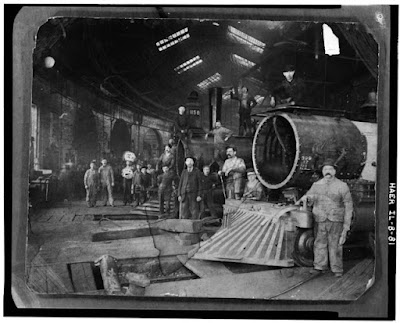This is a continuation of the group of blog articles I previously posted, including I’ve Been Working on the Railroad, I’ve Been Working in the Station, and I’ve Been Working on a Section Crew
Why Roundhouses? Roundhouses gave crews space to work on the locomotives and other rolling stock (passenger coaches, freight cars, wood/coal tenders, etc.). They also kept locomotives and equipment within easy reach. A roundhouse complex often included a blacksmith shop, paint shop, coach shop, and car shop.
The first roundhouse is believed to have been built in Birmingham, England, in about 1837. Although it cannot be confirmed due to loss of records, it is believed the first in the US was built by the Baltimore and Ohio at Mt. Clare, Baltimore, Maryland, about 1840.
 |
| 1880s near Palenstine, Texas |
Early roundhouses, especially those built in cold climates, were fully enclosed, with the turntable as well as the stalls under cover. Once locomotives became too large to fit in these structures, they were torn down and replaced with "doughnut"-shaped structures that surrounded an open turntable.
Although some roundhouses used by Class 1 railroads were built as a full-circle with as many as 52 stalls, the vast majority were only part of a circle with 12 or fewer stalls.
1878-85 Chicago, Burlington & Quincy RR Roundhouse
There was a reason most such facilities were round. The circular design allowed for a compact layout, keeping the locomotives and equipment inside closely spaced and within accessible reach. The building pattern was flexible, permitting a railroad to add stalls to an existing roundhouse (or remove them) as conditions warranted. The turntable used to access each roundhouse stall did not require multiple switches (such as using “Y” tracks) to move locomotives from place to place, thus simplifying moving the heavy pieces equipment between the tracks and repair bays.
Workers pose outside the Detroit, Toledo & Milwaukee Roundhouse on its original site in Marshall, Michigan, circa 1890-1900.

Utah Central Railroad, Salt Lake City Roundhouse
Roundhouses were
built in a multitude of locations—from the heart of a large city to out on the
open plains. Larger railroads operated multiple roundhouses, generally located
at 100-mile intervals. This was roughly the distance one train crew could
travel in a single shift. The roundhouses on these large railroads served as
relay points where a new locomotive (and crew) took over the train while the
previous locomotive went in for maintenance.
In North America, regular daily serving began with a hostler, a locomotive operator who moves engines around a train yard, moving an engine to an ash pit to remove the detritus of burned wood or coal. The locomotive's tender would be refilled with fuel, water, and sand, and the engine would be placed above an inspection pit so that workers could inspect it for any maintenance needs and to lubricate it.
 |
| Roadhouse, Chicago, Burlington & Quincy RR |
At larger 24-hour North American roundhouses, steam locomotives would often be turned around and made ready for service within a few hours of arrival. However, locomotives with major issues or in need of semi-regular maintenance required additional time were often sent to larger roundhouses staffed with boilermakers, blacksmiths, and pipefitters. Only those engines requiring major unexpected repairs or scheduled major maintenance were transported to specialized backshops.
In the middle of the B&O (Baltimore & Ohio) Railway Roundhouse is their 60-foot turntable. This turntable was used to position passenger cars in an available bay for necessary repairs. The turntable uses no electricity and relies on central ball bearings to freely rotate equipment. When centered properly, a single person can push the turntable.
The roundhouse and its connecting buildings for servicing locomotives on the Chicago & Aurora Railroad. were first opened in 1857.
Roadhouse (1856 and 1859 portions), general view showing columns and roofline - Chicago, Burlington and Quincy Railroad, Roundhouse and Shops, Broadway and Spring Streets, Aurora, Illinois
North side Chicago, Burlington & Quincy RR Roundhouse
By the 1920s, passenger cars became
increasingly longer. More and more, existing roundhouses lost much of their
usefulness. Following World War II, with the widespread adoption of diesel and
electric locomotives—which needed far less maintenance—roundhouses lost much of
their importance. The vast majority of roundhouses were torn down beginning in
the 1950s and gradually disappeared from the American railroad scene.
Located in Jamestown, California, the roundhouse at Railtown 1897 State Historic Park, with its operating entity, the Sierra Railway, is known as "The Movie Railroad." Both entities are a heritage railway and are a unit of the California State Park System. The park preserves the historic core of the original Sierra Railway of California. The railway's Jamestown locomotive and rolling stock maintenance facilities, including its roundhouse, are mostly intact. They are one of the few remaining functioning steam engine facilities and continue to function much as they have for over 100 years.
In my most recent release, Lemon Cookies by Lisbeth, my hero first works as a section crewman for the Denver & Rio Grande Railway in Gunnison, Colorado. Once he decides to relocate to my hypothetical town of Cleora (loosely based on Salida, Colorado), he looks for work in the roundhouse.
Lemon Cookies byLisbeth is currently available as an ebook for sale and at no additional cost with a Kindle Unlimited subscription. To find the book description and purchase options,
Please CLICK HERE
Sources:
https://www.thehenryford.org/explore/blog/the-railroad-roundhouse
https://www.borail.org/collection/roundhouse/
https://www.frrandp.com/2018/12/the-aurora-roundhouse-from-railroad.html
https://www.borail.org/explore-learn/exhibitions/the-roundhouse/
https://community.utah.gov/westside-stories-image-gallery/
https://commons.wikimedia.org/wiki/File:Aurora_Roundhouse.jpg
https://commons.wikimedia.org/wiki/File:Roadhouse,_stalls_18-23,_shop_crew_and_two_locomotives._Photographed_possibly_between_1878_and_1885_-_Chicago,_Burlington_and_Quincy_Railroad,_Roundhouse_and_Shops,_Broadway_and_HAER_ILL,45-AUR,1-81.tif
https://commons.wikimedia.org/wiki/File:Detail_showing_the_joining_of_the_roundhouse_and_the_shop,_from_the_southwest._-_Chicago,_Burlington_and_Quincy_Railroad,_Roundhouse_and_Shops,_Broadway_and_Spring_Streets,_HAER_ILL,45-AUR,1-100.tif
https://commons.wikimedia.org/wiki/File:Detail_of_the_north_side_of_the_roundhouse._-_Chicago,_Burlington_and_Quincy_Railroad,_Roundhouse_and_Shops,_Broadway_and_Spring_Streets,_Aurora,_Kane_County,_IL_HAER_ILL,45-AUR,1-98.tif
https://commons.wikimedia.org/wiki/File:Roundhouse_LOC.fsa.8d23258.jpg
https://commons.wikimedia.org/wiki/File:EMRR_Roundhouse.jpg
https://commons.wikimedia.org/wiki/File:Providence_and_Worcester_Railroad_Roundhouse_Providence.jpg
https://en.wikipedia.org/wiki/Railtown_1897_State_Historic_Park





%20pub%20dom.jpg)





















